
Cornmarket Street is a major shopping street and pedestrian precinct in Oxford, England that runs north to south between Magdalen Street and Carfax Tower.
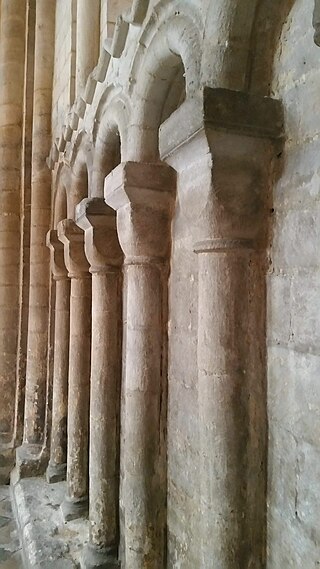
An arcade is a succession of contiguous arches, with each arch supported by a colonnade of columns or piers. Exterior arcades are designed to provide a sheltered walkway for pedestrians; they include many loggias, but here arches are not an essential element. An arcade may feature arches on both sides of the walkway. Alternatively, a blind arcade superimposes arcading against a solid wall.
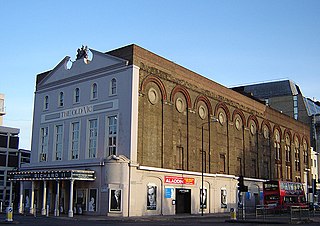
The Cut is a street in London which runs between Waterloo Road in Lambeth and Blackfriars Road in Southwark, approximately parallel to the South Eastern Railway. The Old Vic theatre is at the western (Lambeth) end, and the more experimental Young Vic theatre halfway along on the other side. Lewisham Southwark College is sited on the south side of the Cut and at the eastern (Southwark) end is Southwark Underground station. Waterloo and Waterloo East stations are also nearby.

Turl Street is a historic street in central Oxford, England.

The High Street in Oxford, England, known locally as the High, runs between Carfax, generally seen as the centre of the city, and Magdalen Bridge to the east.

Broad Street is a wide street in central Oxford, England, just north of the former city wall. The street is known for its bookshops, including the original Blackwell's bookshop at number 50, located here due to the University of Oxford. Among residents, the street is traditionally known as The Broad.
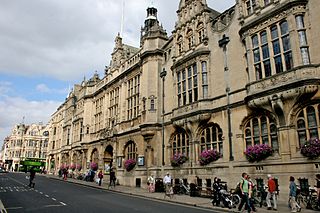
St Aldate's is a street in central Oxford, England, named after Saint Aldate, but formerly known as Fish Street.

Queen Street is a pedestrianised shopping street in central Oxford, England. It is one-way for buses and taxis, two-way for cyclists outside main shopping hours, and forbidden for cars. It runs west from the centre of Oxford at Carfax. Here it adjoins Cornmarket Street to the north, the High Street continuing east, and St Aldate's to the south.

Kirkgate Market is a market complex on Vicar Lane in the city centre of Leeds, West Yorkshire, England. It is the largest covered market in Europe and a Grade I listed building. There are currently 800 stalls which attract over 100,000 visitors a week.
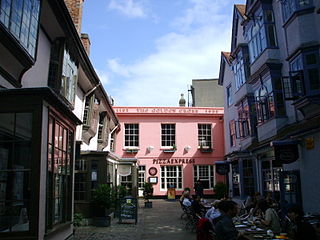
Golden Cross is a shopping arcade at 5 Cornmarket Street in central Oxford, England. The original structure on the site dates from 1193, when it was called Maugershall after the then owner, and consisted of shops with an inn on the upper storeys. The building structures now on the site date from the late 15th century, when they were used as a traditional coaching inn, as is clear from its layout and historical documents. The collection of historic buildings in the Golden Cross courtyard to the east off Cornmarket Street, one of Oxford's main shopping streets. Golden Cross is now used as Oxford's branch of Pizza Express. The courtyard is used as a thoroughfare which leads to the historic Covered Market and has been redeveloped as a small shopping centre, with upmarket shops, a branch of iGlasses Opticians, Holland and Barrett and a Chinese herbalist.

The Great Market Hall or Central Market Hall, Market Hall I is the largest and oldest indoor market in Budapest, Hungary. The idea of building such a large market hall arose from the first mayor of Budapest, Károly Kamermayer, and it was his largest investment. He retired in 1896 and participated in the opening ceremony on February 15, 1897.

Market Street is a street in central Oxford, England, running east to west.
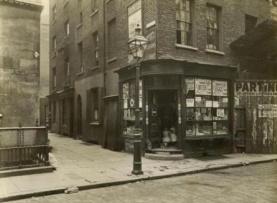
Clare Market is a historic area in central London located within the parish of St Clement Danes to the west of Lincoln's Inn Fields, between the Strand and Drury Lane, with Vere Street adjoining its western side. It was named after the food market which had been established in Clement's Inn Fields, by John Holles, 2nd Earl of Clare. Much of the area and its landmarks were immortalised by Charles Dickens in The Old Curiosity Shop, The Pickwick Papers, Barnaby Rudge and Sketches by Boz.

A marketplace or market place is a location where people regularly gather for the purchase and sale of provisions, livestock, and other goods. In different parts of the world, a marketplace may be described as a souk, bazaar, a fixed mercado (Spanish), or itinerant tianguis (Mexico), or palengke (Philippines). Some markets operate daily and are said to be permanent markets while others are held once a week or on less frequent specified days such as festival days and are said to be periodic markets. The form that a market adopts depends on its locality's population, culture, ambient and geographic conditions. The term market covers many types of trading, as market squares, market halls and food halls, and their different varieties. Thus marketplaces can be both outdoors and indoors, and in the modern world, online marketplaces.

Surrey Street Market is a street market located in Surrey Street, Croydon, south London. Records of a market on the site date back to the 13th century.

Newport Market is a traditional Victorian indoor market, in Newport, South Wales. It is an early example of a large-span cast iron-frame building featuring a glass-filled barrel roof.

The Birmingham Wholesale Markets are the largest combined wholesale fresh produce markets in the United Kingdom, with 90 trading units totalling 31,000 m2 (330,000 sq ft). Located at The Hub in Witton and easily accessible to the M6 Motorway, they include markets selling meat, fish, poultry, fruit, vegetables and flowers and are run by Birmingham Wholesale Market Company a joint venture between the tenants represented by the Birmingham Wholesale Fresh Produce Association and Birmingham City Council as landlords.

Norwich Market is an outdoor market consisting of around 200 stalls in central Norwich, England. Founded in the latter part of the 11th century to supply Norman merchants and settlers moving to the area following the Norman conquest of England, it replaced an earlier market a short distance away. It has been in operation on the present site for over 900 years.

Stocks Market was a market in central London operating between 1282 and 1737 and for centuries was London's main retail meat and produce market.

The Pannier Market in Bideford in North Devon is a large covered Victorian pannier market together with the Butcher's Row of small artisan stalls running along the lower level of the Market. There has been a market on the site since 1675. Since 1989 it has been a Grade II listed building on the register of Historic England.




























